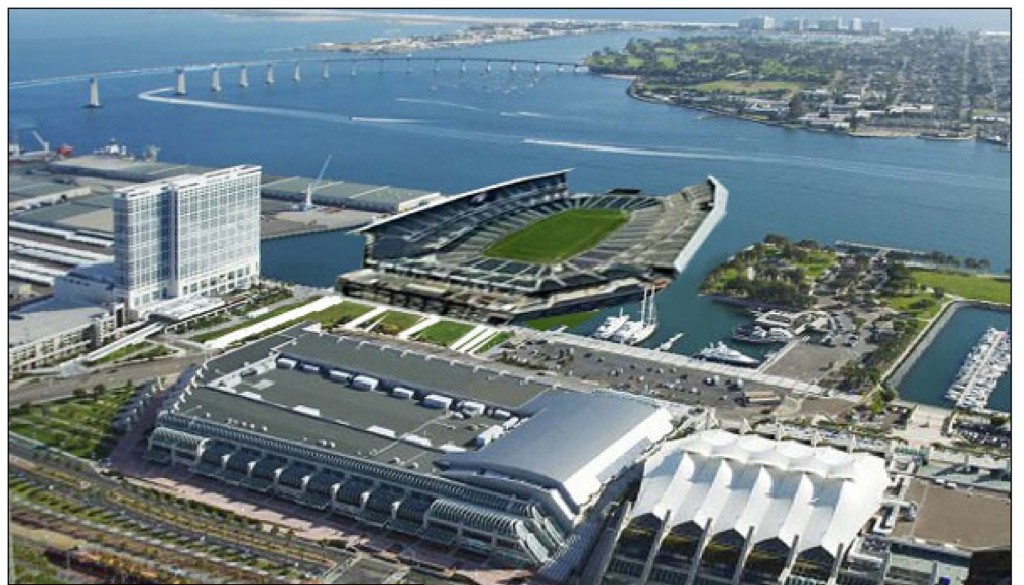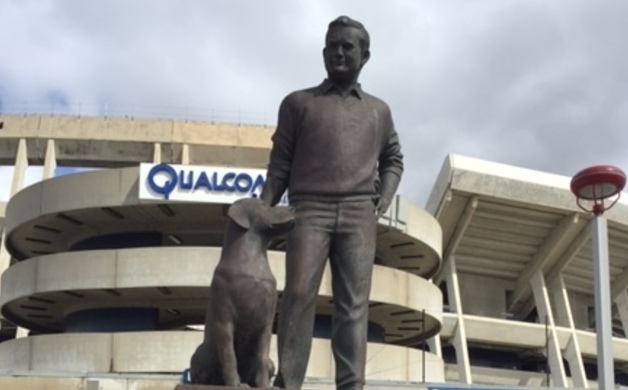Commentary by Louis Rodolico
*Updated
If you were around 50 years ago you may remember Jack Murphy’s dream of a floating stadium. City Council and Jack were serious about it, but, at that time, the floating stadium was too expensive. So the Padres and Chargers partnered on a dual use San Diego Stadium, built on land in Mission Valley. On August 20, 1967 the Chargers played their first game at San Diego Stadium. In 1980 the voters approved changing the name to Jack Murphy Stadium. In 1997 Qualcomm agreed to pay the city 18 million dollars for stadium improvements in exchange for a name change to Qualcomm Stadium.
As an homage to Jack, and a way to find the Chargers some new partners, let’s take a fresh look at the potential of a floating stadium.
The current Qualcomm stadium costs San Diego taxpayers 12 million a year, there is maintenance and 40 million dollars left to pay on the most recent improvements. The Chargers would like us to build them a new stadium downtown, which would involve granting them the use of a site. The taxpayers are also being asked to pay for about half the cost of a new stadium. Football teams play about 12-14 home games yearly, that’s less than 4% of the days of the year. If there was a second football team who could share the new stadium, then the stadium would be used 8% of the time. If two football teams go to LA that would be a stadium used 12% of the time. The numbers begin to make sense.
 The Floating Stadium, shared by both Los Angeles and San Diego, may not be as tongue and cheek as one might think. The NFL, or other third party, would own the stadium so taxpayers would be off the hook. It’s a vessel not a building so Development Services would be off the hook as well. It would garner international interest. The Floating Stadium would have upper seating that was hydraulically lowered for transport. It could have its own water purification plant and (solar) power generation. Our harbor is 2,000 feet wide and the Floating Stadium would only need to be 500 feet wide. There would be excitement when the stadium came to town, kind of like the circus. In order to minimize trips the NFL would probably alter schedules so both San Diego and Los Angeles teams played multiple home games in a row. The Stadium would still be available 80% of the time for soccer and other revenue generating events, for all west coast cities including Mexico. The best part is if the NFL decides it no longer wants to play, at a given location, they can raise the anchor and move to greener pastures. The local taxpayers will not be saddled with demolishing and removing a large structure like the current stadium in Mission Valley.
The Floating Stadium, shared by both Los Angeles and San Diego, may not be as tongue and cheek as one might think. The NFL, or other third party, would own the stadium so taxpayers would be off the hook. It’s a vessel not a building so Development Services would be off the hook as well. It would garner international interest. The Floating Stadium would have upper seating that was hydraulically lowered for transport. It could have its own water purification plant and (solar) power generation. Our harbor is 2,000 feet wide and the Floating Stadium would only need to be 500 feet wide. There would be excitement when the stadium came to town, kind of like the circus. In order to minimize trips the NFL would probably alter schedules so both San Diego and Los Angeles teams played multiple home games in a row. The Stadium would still be available 80% of the time for soccer and other revenue generating events, for all west coast cities including Mexico. The best part is if the NFL decides it no longer wants to play, at a given location, they can raise the anchor and move to greener pastures. The local taxpayers will not be saddled with demolishing and removing a large structure like the current stadium in Mission Valley.I am not against football, I am searching for an alternative that eliminates taxpayer dollars to build a new stadium and to demolish it later. The Qualcomm naming rights expire next year. Who knows, maybe Qualcomm, or a new Floating Stadium, will be named Jack Murphy Stadium once again.
Louis Rodolico is a Candidate for City Council District 1
For more information visit: www.louisrodolico.com
*Edited May 10th, 2016




